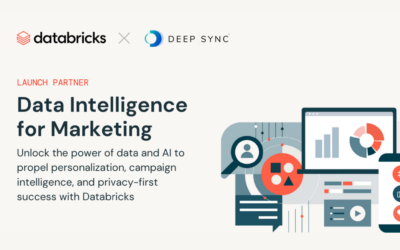2025 will bring widespread changes for marketers and advertisers. Here are the marketing and data trends we’ll be watching this year.
As the marketing and advertising industries continue to evolve, staying ahead of the curve will remain essential for businesses’ ongoing success. 2024 brought some widespread changes, but 2025 may present even larger challenges.
This year, we expect the industry to be shaped by:
- The unreliability of third-party cookies
- Signal loss resulting from privacy legislation
- Updates to social media networks
- The industry’s growing walled gardens
- Rising postal rates
- The ever-increasing relevance of AI
- Changes to Retail Media Networks
- Marketers’ increased reliance on the cloud
Here are a few thoughts from Paul Turner, our GM, Digital:
Watch the full video to learn more.
These trends will undoubtedly influence how businesses craft and execute their marketing strategies this year. In this blog post, we’ll cover each of the upcoming changes, how they will affect your business, and our recommended strategies for navigating these changes.
Third-party cookies will become unreliable.
Here’s what’s happening:
We’ve been expecting cookies to go the way of floppy disks and VHS tapes for a while now. But even though cookies are here to stay, they will be severely limited (and unreliable) going forward. Due to Google’s new opt-in model and consumers’ growing demand for privacy, it’s no surprise that advertisers are moving away from third-party cookies.
Here’s why it matters:
In light of cookie instability, brands and agencies need alternative, durable methods for addressing their desired audiences—methods that prioritize consumer privacy. In response to this evolving digital landscape, the marketing and advertising industries must adapt and innovate. There are several paths forward, including durable, interoperable IDs, new measurement technologies, and a shift to first-party data.
In the broader advertising industry, much will be made of Google’s “Sandbox” approach. However, this approach has already been met with skepticism for a few reasons:
- If Google decides to change the Sandbox—as they did with cookies—it will once again upend advertising.
- The Sandbox is limited in its effectiveness and only truly offers a suitable alternative to retargeting and contextual advertising.
- This approach will make large platforms with access to scalable first-party data even more powerful.
- The growing impact of large platforms will put a strain on small and mid-sized publishers, as they will be forced to collaborate with larger players.
One of the counters for a world where there are fewer anonymous identifiers is to build a robust first-party data strategy. But, that presents a challenge: The majority of marketers and publishers don’t see enough first-party data to power their acquisition efforts effectively. Because of this, advertisers will experience a growing need for better identity data and targeted segments in 2025.
Here’s what we recommend:
Beyond an increased focus on first-party data capture—which should be paramount this year—marketers and advertisers will need alternative solutions to reach audiences and measure engagement. It’s time to start testing different strategies, which include everything from modeling to predictive audiences to contextual targeting to using alternative IDs.
There will be a deeper-than-ever focus on modeling and interconnectivity. Marketers and agencies don’t want to outsource all of their audience knowledge to a single platform. By controlling the modeling process and the analysis, they can have a deeper knowledge of their ideal market and can more easily build omnichannel campaigns that align.
Contextual targeting leverages sophisticated algorithms to identify contextual signals across the internet, allowing marketers and advertisers to reach the right audience according to the content they consume. While Google’s Sandbox does provide an alternative for cookieless contextual targeting, there are other solutions available to help businesses place ads for the right audience in the right context.
Fewer, but higher quality, third-party data solutions—powered by a robust identity graph—will be key in this new world. These data solutions will bring about larger conversations on durable, interoperable identifiers such as The Trade Desk’s UID2 and Deep Sync’s individual, household, and address-level identifiers. According to early studies, these types of identifiers have led to 40% – 50% CRM increase. Although many of these identifiers are relatively new, their impact will continue to grow in 2025.
Privacy regulations are leading to signal loss.
Here’s what’s happening:
20 states across the United States—including California, Colorado, and Virginia—have enacted comprehensive data privacy laws. Five new laws will go into effect by January 16, 2025, giving consumers more rights to access, delete, and opt out of selling their data.
Although the scope of each state’s law is different, each of these laws will have the same effect: These laws will lead to even more signal loss as businesses face increasing restrictions on how they collect, share, and use consumer data.
Here’s why it matters:
Signal loss is the decline in available user-level identifiers. This decline makes it difficult for advertisers to track, measure, and optimize their campaigns.
Marketers and advertisers that don’t find ways to compensate for ongoing signal loss will experience decreased reach and incorrect attribution. And since 89% of brand and agency buyers in the U.S. have already reported that personalization tactics have been negatively impacted by signal loss, the customer experience may also be affected.
Here’s what we recommend:
Ongoing signal loss will require advertisers to rely on their first-party data. Data solutions will enable marketers to maximize the potential of their own data, which will help with personalization and engagement efforts. But, the changing landscape will require marketers to invest in privacy-safe ways to collect, store, and activate customer data.
To find the balance between maintaining customers’ trust and delivering effective campaigns, companies will need to adjust their data strategies to focus on transparency and user consent. Alternatively, many companies may turn to walled gardens that have large amounts of first-party data, including Google, Meta, and retail media networks.
We recommend searching for privacy-centric solutions, like cloud-based collaboration and data clean rooms, as well as reputable data providers. Finding the right partners to help navigate the data privacy landscape and signal loss will be crucial in these challenging times.
With these strategies, marketers will be able to overcome the hurdles caused by signal loss and continue to effectively reach and engage their audiences.
Major changes are coming to social media.
Here’s what’s happening:
Social media networks are making significant changes that will affect advertising. Here are the changes that are happening on each major channel:
- Meta has announced stricter targeting and data usage restrictions for advertisers in special ad categories like health and wellness, financial services, and politics.
- LinkedIn discontinued its lookalike audiences, making targeting based on your existing customers more difficult.
- TikTok may soon be banned in the U.S., leading both users and advertisers to explore alternate platforms.
These changes will change the way marketers and advertisers reach and engage with audiences on these platforms.
Why it matters:
Meta announced that it will restrict advertiser access to special ad categories—like health and wellness, financial services, and politics—for shared customer list custom audiences. These changes will reduce the types of data advertisers can use to reach consumers, limiting targeting abilities. These changes may also make Meta’s “campaign optimization” tools less functional.
LinkedIn discontinued its lookalike audiences in early 2024, meaning that marketers can’t create new lookalike audiences or edit existing ones, and lookalike audience data no longer refreshes.
As for TikTok, the platform is facing high-profile legal challenges. While it remains to be seen if the app will be banned—in light of the Supreme Court case and a new presidential administration—many users and advertisers are exploring new platforms. YouTube and Meta may attract users due to the ease of sharing video content. However, Bluesky has seen an incredible 500% growth due to its reputation as a “safe haven” for users fleeing Twitter/X; this growth may continue if TikTok does get banned nationwide.
What we recommend:
With these changes coming to social media platforms, advertisers will be affected by the loss of data, loss of targeting abilities, and possibly even the loss of entire platforms.
On Meta, advertisers should seek out third-party audiences that comply with Meta’s new policies. With the right data, advertisers will be able to keep campaigns running smoothly. Many Meta audiences are available on Deep Sync One, including audiences related to health and wellness, financial attributes, and politics. Once audiences are selected, they can be distributed to advertisers’ Meta ad accounts for campaigns.
To adapt to the loss of lookalike audiences, LinkedIn recommends: “Predictive audiences for contact list, conversion, or Lead Gen Form data sources [and] Audience Expansion for Matched Audiences and LinkedIn attribute targeting, such as by skill or interest.”
If TikTok is banned, we recommend that advertisers lean into video-based advertising on YouTube and Meta. Influencer marketing may also experience growth, as creators who built significant platforms on TikTok may have loyal audiences that follow them to other platforms.
In the face of all of the changes to social media, smaller marketing teams might consider exploring other avenues like search ads or relying more heavily on organic content. For larger marketing teams, we recommend spreading your efforts across channels and platforms.
Targeting the same audience across disparate channels requires a significant understanding of audience targeting, addressability, and how to use your customer data. But, that’s where data providers like Deep Sync can provide expertise and help marketers have more control over their audiences—regardless of the changes to social media platforms.
Walled gardens are limiting the open internet.
Here’s what’s happening:
Marketers are increasingly concerned with navigating the industry’s growing walled gardens. The largest walled gardens are expected to account for 83% of global digital advertising revenue by 2027.
Why it matters:
Platform-specific walled gardens create significant challenges for marketers. As the “open internet” becomes increasingly restricted, effective omnichannel campaigns become more difficult to execute. These walled-off silos among disparate channels cause fragmented audience targeting. For marketers and advertisers, it’s increasingly important not to let these platforms own your customer relationships.
What we recommend:
Marketers and advertisers need to gain more control over their customer relationships—their data, targeting, attribution, and more. The most effective strategy is to build an audience and then activate that same audience across multiple channels. However, most companies lack the expertise and/or bandwidth to build an audience that benefits from complete portability across platforms and channels. A data provider can help by making an audience and delivering it across all online and offline channels.
Postal rates are rising… again.
Here’s what’s happening:
The United States Postal Service (USPS) will once again raise postal rates; by January 19, 2025, the costs of various shipping services will increase. The cost of First Class Mail will remain the same, and Forever Stamps will stay at 73 cents (up from 68 cents in mid-2024). Since 2023, mailing rates have increased the most in USPS’s history, making it more expensive for direct mail marketers.
Why it matters:
Many businesses rely heavily on direct mail to attract new customers. For these marketers and advertisers, USPS’s rate increases will significantly impact ROI. To mitigate the financial impact, brands will need to adapt their strategies to account for rate increases.
What we recommend:
A combination of first-party data solutions and high-quality third-party datasets is the solution to optimizing your direct mail ROI. Perhaps the most impactful solution is a data hygiene service. After all, if your database has outdated, incorrect, or incomplete addresses, you won’t be able to reach your customers with a direct mail campaign. A data hygiene service can ensure that you don’t waste resources sending to incorrect addresses. Couple this with a data append, and it becomes possible to update and find mailing addresses for the contacts in your database.
Analytics and other insights can also be useful tools to navigate postal rate increases. For example, consider how recipients have engaged with your content previously. Contacts that have not engaged with previous direct mail campaigns are less likely to respond to future mailings.
To take that a step further, mailing to scored data produced via a predictive analytics program will ensure that you are reaching those most likely to respond. Reaching contacts where they respond best—whether that be on social media, CTV, SMS, or direct mail—will help you maximize the impact of your budget.
AI is on the rise!
Here’s what’s happening:
From ChatGPT to social media and everywhere in between, artificial intelligence (AI) will continue to shake up the industry as we know it. AI does enable tremendous innovation, as underscored by Databricks’ massive $62 billion valuation.
While AI is not without risks, it offers endless opportunities from content creation to campaign optimization to audience-building capabilities.
Why it matters:
AI isn’t perfect; it needs access to enough data to learn from for it to improve. This will present a challenge, as using the wrong data can violate copyright laws, user privacy, and ethical guidelines. It’s also important to remain aware of and mitigate AI bias.
Specific to marketing, we’re already seeing data-rich platforms like Meta and Google offer AI-based optimization capabilities. These are likely to work well for smaller marketing budgets and for single-channel campaigns.
Regardless, if used wisely, AI can take your data strategy to the next level. To reach its full potential, AI needs three things: data, the ability to process that data, and bandwidth to develop the data to train AI models.
What we recommend:
Generative AI can be used to process vast quantities of data; this will make it particularly effective to analyze customer data to uncover detailed insights about preferences and behaviors, including digital behavior, purchasing patterns, engagement, and more. This information can enable customized product suggestions, content, and more. In this way, AI can provide a solution for the signal loss created by Google’s cookie deprecation.
With time, evolution, and training, companies will eventually be able to expand AI and machine learning for predictive analytics. This will allow teams to predict consumers’ likely next steps, allowing for more proactive and personalized strategies.
AI can also be used to simplify complex audience-building processes. For example, AI-powered lookalike audiences can help companies find new customers.
For enterprises that don’t want to (or can’t) use their first-party data to train AI models, deterministic data can be used. In this way, third-party datasets can be used as a truth set for modeling and training—without violating copyright laws.
Retail media networks are facing challenges.
Here’s what’s happening:
Retail media networks (RMNs) allow retailers to offer their first-party data to other, third-party businesses for advertisement purposes. Marketers can purchase this advertising space, allowing them to use retailers’ first-party data to connect with in-market prospects who are likely to buy. This process allows advertisers to show ads across retailers’ websites, including home pages, search result pages, product detail pages, and category pages.
Retail media is expected to hit $81.6 billion in ad spending by 2025; this will make retail media 23.5% of the total advertising market in the U.S. With so many new retail media networks entering the space in 2024—such as Experian, Expedia, and T-Mobile—it’s no surprise that marketers are paying attention to these channels!
Why it matters:
Retail media networks are changing the way businesses and shoppers interact with each other. The benefits of effective RMNs are:
- For retailers: an extra revenue stream
- For advertisers: access to retailers’ first-party data
- For consumers: a personalized shopping experience
But, there are also challenges that come when working with RMNs. Larger brands can outbid and outperform smaller ones, creating an unequal playing field. And with siloed data and disparity between networks, advertisers face walled gardens and issues with measurement, attribution, and a lack of standardization across platforms.
Retail media networks are also facing challenges. They’re overrun with ads, need to expand their audience, and supply hasn’t caught up to enable them to scale their revenue. They’re also facing numerous challenges: their data is messy due to a lack of good hygiene practices and identity resolution, they don’t have full access to their entire customer base, and they deal with an inconsistent stream of data. These challenges pose a threat to the ongoing success of retail media networks.
What we recommend:
Retail media networks should seek identity resolution services and implement good data hygiene practices. These services could help inform retailers which email addresses of their customers are their primary based on recency and frequency. These services can also help match individuals to their household addresses, making it easier for retailers to locate people wherever they are online—including CTV—without super high CPMs.
Retailers can also benefit from additional data, as most retailers don’t have full access to their customer base. They don’t know who is in the aisles and paying with cash vs. who is a loyalty member vs. who is on their website/apps. A third-party data provider can provide access to the full U.S. consumer base, helping retailers amplify their reach.
The influence of cloud software is growing.
Here’s what’s happening:
Marketers and advertisers have a continued—and growing—interest in cloud software. Over the next 10 years, Gartner predicts that cloud software will become a “pervasive and essential driver of business innovation.
Why it matters:
Cloud platforms, like Snowflake, offer their clients a secure place to collate, store, and analyze data. Third-party data sales used to predominantly occur on major ad platforms like Google, Facebook, and The Trade Desk.
With increasing privacy concerns, it’s become more difficult for companies to monetize their data without creating their own walled gardens, as sharing data outside of the cloud can create privacy risks. These changes will increasingly shift the location of third-party data sales to the cloud.
What we recommend:
Marketers should continue to learn more about the cloud and the growth potential it provides. For example, a partnership between Narrative, Snowflake, and The Trade Desk has now made it possible for companies who store their data on Snowflake to make that data available for sale in The Trade Desk’s marketplace. Continuing to learn more about cloud platforms, and the native applications available in cloud marketplaces, will serve marketers well in 2025 and beyond.
TL;DR: It’s time to focus on data.
While each of these evolving trends differs in impact, data will be the overarching solution to navigating these changing landscapes. Focusing on first-party data strategies and filling in the gaps with third-party data will be the key to success in 2025 and beyond.
As the leading independent provider of consumer addressability solutions, Deep Sync empowers agencies and brands to reach consumers across their preferred channels. Our data solutions and integrations provide marketers and agencies with access to high-quality, privacy-safe audiences for offline and online uses. Deep Sync powers audience targeting with rich datasets, a highly scalable multichannel identity graph, and a range of intelligent data applications. Book a meeting with us to learn how we can help you navigate the changing industry.












0 Comments